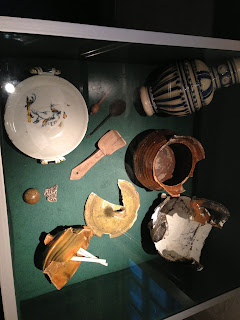Ah, Peter
Today's main excursion was a visit to the Hermitage Museum in Amsterdam. As I mentioned in yesterday's post, until just before I arrived here, this museum had held the Van Gogh Museum's collection during the restoration of that building. Unfortunately for me, the collection is now in transit back to its home, so I will not get to view the Van Gogh paintings this trip. Still, the Hermitage is currently showing an exhibit on Peter the Great, with materials on loan from its mothership, the Hermitage in St. Petersburg, Russia.
Overall, the exhibit was a little bit disappointing, but possibly in large part because I had my mind set to view more great art. Still, I enjoyed it and learned quite a few interesting things about a man I had studied when I was a child. (St. Petersburg, Florida, where I grew up, is the sister city of Peter the Great's St. Petersburg, so the interest was a natural one.)
For example, Peter created a club, The All-Joking, All-Drunken Synod, and he issued a decree with rules for it.
When Peter partied, he partied hard.
I also had never internalized how tall he was: nearly six feet seven inches tall. Seeing a cloak made to his size was illuminating.
Peter was deeply into medicine of all sorts. He traveled with an extensive medicine cabinet.
And his own portable latrine, for apparently he suffered from frequent intestinal distress (and hemmorhoids).
Peter kept with him a large set of personal medical instruments, some of which, along with a very cool medical pop-up book, you can see here.
In the left rear are a tooth extractor and a bone saw. Front left is a cauterizer. To the right are the duck-billed anal speculum and a trepanning drill. If you complained of ailments and Peter heard you, he was apt to come after you and insist on treating you himself. As the exhibit noted, people in his circle were particularly afraid of his tooth pliers and would never complain of a toothache.
Who could blame them?
Over time, Peter assembled, in large part with the help of agents out shopping for him but also from gifts from friends, his own kunstkammer. It included these medical exhibits: the wet-preserved partial arm and partial head of a child, and the dry-preserved foot of a child.
Peter's interests were vast and varied.
He loved to work at lathes, such as this beauty of his.
Friedrich-Christian Weber, an envoy from Hanover in St. Petersburg, wrote,
"Usually he is in the Secret Council from three to four in the morning. Then he visits the shipyard, directs the works and contributes in person, for he knows the profession, from the tiniest details to the grandest line. Around nine or ten o'clock he relaxes by working on a lathe, where he makes the most magnificent things."Among the art in his collection were many pieces from the Orient. I particularly liked this one, which an artist carved from the roots of a tree to tell the stories of the eight immortal figures of Buddhism.
The gem of the collection, though, was this Rembrandt, David's Farewell to Jonathan, which was absolutely stunning in person.
Out on the street, a sofa had appeared next to the canal, and a party was growing around it. (Sorry about the finger in the shot.)
A drawbridge!
A chance encounter with a small garden behind a locked fence.
The cast of Rembrandt's Night Watch as statues standing in front of a statue of the man himself in the square that bears his name.
Wandering is wonderful fun here.


























































